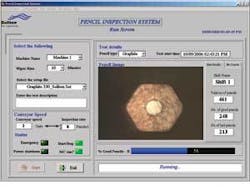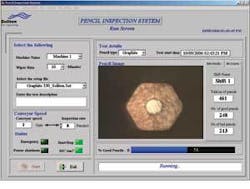System speeds pencil inspection and sorting
Andrew Wilson, Editor, [email protected]
By sandwiching lead between two very long wooden pieces or slats that are then separated by sawing, one pencil manufacturer in India is producing more than 2 million pencils per day in one of its new factories. “During the manufacturing process,” says Ganesh Devaraj, managing director of Soliton Technologies (Bangalore, India; www.solitontech.com), “the pencil is prone to defects such as wood chip-offs and cracks that affect the pencil both functionally and aesthetically. Other defects such as lead offset cause pencil leads to break while being sharpened. All of these defects must be found before the pencils are lacquered, finished, and boxed.
“When the factory was manufacturing 1 million pencils/day, 60 people were employed to manually inspect and remove defective pencils. Although the quality of inspection and sorting was just acceptable, our customer was acutely aware of the inability of the manual inspection to measure lead offset in the pencils. Only when the lead offset was large was it detected by the manual inspector,” continues Devaraj.
To produce better quality pencils, this lead offset needed to be contained to within 300 µm, a figure that was impossible to judge manually. When production needed to be increased to 2 million pencils per day, the manufacturer decided to go for a fully automated inspection and sorting system. Such throughput mandated a throughput of 23 pencils/s and that various types of color and graphite pencils were inspected and sorted into different bins based on defect type.
Soliton commissioned the Machine Building and Automation Division of Titan Industries (www.tata.com/titan/index.htm) to design and build the material-handling system. Consisting of a conveyor, motor, motor controller, encoder, and ejection mechanism, the conveyor can transport 23 pencils/s in front of the cameras with minimal vibration.
How it works
Pencils are loaded into a hopper from which they are dropped onto the conveyor. Each of the two ends of the pencil is inspected by two Soliton M310_CFW13 1.3-Mpixel IEEE 1394 color cameras. As each pencil traverses the conveyor, beam sensors trigger each camera. Depending on the type of pencils being inspected, either a fiberoptic ringlight or a fluorescent light is powered.
Each of the two cameras is interfaced to a dedicated PC with a 2.5-GHz P4 processor and 1 Gbyte RAM running Windows XP. The two PCs are networked via Ethernet to provide a single user interface to the operator. Using LabVIEW from National Instruments (Austin, TX, USA; www.ni.com) with the IMAQ vision library, algorithms for the detection of each type of defect were created.
“One of the most challenging parts of the design was to develop fast and robust image-processing algorithms to detect all the defects and meet the cycle-time requirement of 40 ms,” Devaraj says. “Lead-offset measurement accuracy was verified through independent measurements and repeatability trials. For the development of the vision algorithms and for the optimization of the processing speed, the performance meter within NI Vision Builder proved indispensable.”
Once the pass/fail result for each pencil is obtained, defective pencils are ejected a reject bin, and the good pencils collected in another bin. Defective pencils are ejected pneumatically under control of a high-speed microcontroller-based ejector synchronization board custom built by Soliton. This receives pass/fail results from the two PCs, keeps track of the conveyor movement using the encoder pulses from the conveyor motor, and then fires pneumatic valves at the appropriate time to eject defective pencils.

